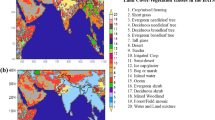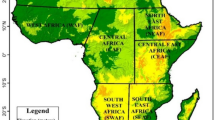Abstract
Carbon dioxide (CO2) is a major climate forcing factor, closely related to human activities. Quantifying the contribution of CO2 emissions to the global radiative forcing (RF) is therefore important to evaluate climate effects caused by anthropogenic and natural factors. China, the United States (USA), Russia and Canada are the largest countries by land area, at different levels of socio-economic development. In this study, we used data from the CarbonTracker CO2 assimilation model (CT2017 data set) to analyze anthropogenic CO2 emissions and terrestrial ecosystem carbon sinks from 2000 to 2016. We derived net RF contributions and showed that anthropogenic CO2 emissions had increased significantly from 2000 to 2016, at a rate of 0.125 PgC yr−1. Over the same period, carbon uptake by terrestrial ecosystems increased at a rate of 0.003 PgC yr−1. Anthropogenic CO2 emissions in China and USA accounted for 87.19% of the total, while Russian terrestrial ecosystems were the largest carbon sink and absorbed 14.69 PgC. The resulting cooling effect was −0.013 W m−2 in 2016, representing an offset of −45.06% on climate warming induced by anthropogenic CO2. This indicates that net climate warming would be significantly overestimated if terrestrial ecosystems were not included in RF budget analyses. In terms of cumulative effects, we analyzed RFs using reference atmospheres of 1750, at the start of the Industrial Revolution, and 2000, the initial year of this study. Anthropogenic CO2 emissions in the study area contributed by + 0.42 W m−2 and +0.32 W m−2 to the global RF, relative to CO2 levels of 1750 and 2000, respectively. We also evaluated correlations between global mean atmospheric temperature and net, anthropogenic and natural RFs. We found that the combined (net) RF caused by CO2 emissions accounted for 30.3% of global mean temperature variations in 2000–2016.
Similar content being viewed by others
References
Anderson-Teixeira K J, Snyder P K, Twine T E et al., 2012. Climate-regulation services of natural and agricultural ecoregions of the Americas. Nature Climate Change, 2(3): 177–181.
Anselm A J, 2017. China’s efforts in sustainable development: A test case for Nigeria’s environmental sustainability goals. Modern Economy, 8(5): 770–790.
Archer D, Eby M, Brovkin V et al., 2009. Atmospheric lifetime of fossil fuel carbon dioxide. Annual Review of Earth and Planetary Sciences, 37(1): 117–134.
Boden T A, Marland G, Andres R J, 2017. Global, regional, and national fossil-fuel CO2 emissions. doi: https://doi.org/10.3334/CDIAC/00001_V2017.
Cao M K, Li K R, 2000. Perspective on terrestrial ecosystem-climate interaction. Advances in Earth Science, 15(4): 446–452. (in Chinese)
Clark P U, Shakun J D, Marcott S A et al., 2016. Consequences of twenty-first-century policy for multi-millennial climate and sea-level change. Nature Climate Change, 6(4): 360–369.
Clarke D W, Boyle J F, Plater A J, 2017. Particle-size evidence of barrier estuary regime as a new proxy for ENSO climate variability. Earth Surface Processes and Landforms, 42(10): 1520–1534.
Cui Y P, Meadows M E, Li N et al., 2019. Land cover change intensifies actual and potential radiative forcing through CO2 in south and southeast Asia from 1992 to 2015. International Journal of Environmental Research and Public Health, 16(14): 2460.
Cui Y P, Xiao X M, Zhang Y et al., 2017. Temporal consistency between gross primary production and solar-induced chlorophyll fluorescence in the ten most populous megacity areas over years. Scientific Reports, 7(1): 14963.
Dass P, Rawlins M A, Kimball J S et al., 2016. Environmental controls on the increasing GPP of terrestrial vegetation across northern Eurasia. Biogeosciences, 13(1): 45–62.
Davin E L, Noblet-Ducoudré N, 2010. Climatic impact of global-scale deforestation: Radiative versus nonradiative processes. Journal of Climate, 23(1): 97–112.
Eby M, Weaver A J, Alexander K et al., 2013. Historical and idealized climate model experiments: An intercom-parison of Earth system models of intermediate complexity. Climate of the Past, 9(3): 1111–1140.
Fang J Y et al., 2018. Carbon Missions from China and the World: Some Views on Relationships between Carbon Emissions and Socio-economic Development. Beijing: Science Press. (in Chinese)
Fang J Y, Zhu J L, Shi Y, 2018. The responses of ecosystems to global warming. Chinese Science Bulletin, 63(2): 136–140. (in Chinese)
Feddema J J, Oleson K W, Bonan G B et al., 2005. The importance of land-cover change in simulating future climates. Science, 310(5754): 1674–1678.
Feldman D R, Collins W D, Gero P J et al., 2015. Observational determination of surface radiative forcing by CO2 from 2000 to 2010. Nature, 519(7543): 339–343.
Gregg J S, Andres R J, Marland G, 2008. China: Emissions pattern of the world leader in CO2 emissions from fossil fuel consumption and cement production. Geophysical Research Letters, 35(8): L08806.
Heimann M, Markus M, 2008. Terrestrial ecosystem carbon dynamics and climate feedbacks. Nature, 451(7176): 289–292.
Houghton R A, House J I, Pongratz J et al., 2012. Carbon emissions from land use and land-cover change. Biogeosciences, 9(12): 5125–5142.
IPCC, 2013. Climate Change 2013: The Physical Science Basis. Contribution of Working Group I to the Fifth Assessment Report of the Intergovernmental Panel on Climate Change.
Joos F, Roth R, Fuglestvedt J S et al., 2013. Carbon dioxide and climate impulse response functions for the computation of greenhouse gas metrics: A multi-model analysis. Atmospheric Chemistry and Physics, 13(5): 2793–2825.
Kirschbaum M U F, Saggar S, Tate K R et al., 2013. Quantifying the climate-change consequences of shifting land use between forest and agriculture. Science of the Total Environment, 465: 314–324.
Kondo Y, Matsui H, Moteki N et al., 2008. Emissions of black carbon, organic, and inorganic aerosols from biomass burning in North America and Asia in 2008. Journal of Geophysical Research, 116(D08204).
Landry J S, Matthews H D, 2016. Non-deforestation fire vs. fossil fuel combustion: The source of CO2 emissions affects the global carbon cycle and climate responses. Biogeosciences, 13(7): 2137–2149.
Landschützer P, Gruber N, Bakker D et al., 2015. Recent variability of the global ocean carbon sink. Global Biogeochemical Cycles, 28(9): 927–949.
Le Quéré C, Andrew R M, Friedlingstein P et al., 2018. Global Carbon Budget 2018. Earth System Science Data, 10(4): 2141–2194.
Lee D S, Pitari G, Grewe V et al., 2010. Transport impacts on atmosphere and climate: Aviation. Atmospheric Environment, 44(37): 4678–4734.
Li M D, Cui Y P, Qin Y C et al., 2020. Parameter localization of greenhouse gas value model and greenhouse gas storage simulation for forest ecosystems in China. Forests, 11(11): 1150.
Li N, Cui Y P, Fu Y M et al., 2021. Contribution of anthropogenic CO2 in China to global radiative forcing and its offset by the ecosystem during 2000–2015. Annals of the New York Academy of Sciences, 1488(1): 56–66.
Lim C, Kafatos M, Megonigal P, 2004. Correlation between atmospheric CO2 concentration and vegetation greenness in North America: CO2 fertilization effect. Climate Research, 28(1): 11–22.
Loboda T V, Chen D, 2016. Spatial distribution of young forests and carbon fluxes within recent disturbances in Russia. Global Change Biology, 23(1): 135–153.
Loehle C, 2014. A minimal model for estimating climate sensitivity. Ecological Modelling, 276: 80–84.
Lovenduski N S, Gruber N, Doney S C, 2008. Toward a mechanistic understanding of the decadal trends in the Southern Ocean carbon sink. Global Biogeochemical Cycles, 22(3): GB3016.
Mendoza V M, Garduno R, Villanueva E E et al., 2015. Mexico’s contribution to global radiative forcing by major anthropogenic greenhouse gases: CO2, CH4 and N2O. Atmosfera, 28(3): 219–227.
Montenegro A, Eby M, Mu Q et al., 2009. The net carbon drawdown of small scale afforestation from satellite observations. Global and Planetary Change, 69(4): 195–204.
Myhre G, Highwood E J, Shine K P et al., 1998. New estimates of radiative forcing due to well mixed greenhouse gases. Geophysical Research Letters, 25(14): 2715–2718.
National Oceanic and Atmospheric Administration Earth System Research Laboratory, 2016. NOAA’s Annual Greenhouse Gas Index. http://www.esrl.noaa.gov/gmd/aggi/.
Peter W, Jacobson A R, Sweeney C et al., 2007. An atmospheric perspective on North American carbon dioxide exchange: CarbonTracker. Proceedings of the National Academy of Sciences of the United States of America, 104: 18925–18930.
Prather M J, 2007. Lifetimes and time scales in atmospheric chemistry. Philosophical Transactions of the Royal Society A, 365(1856): 1705–1726.
Roe G H, Baker M B, 2007. Why is climate sensitivity so unpredictable? Science, 318(5850): 629–632.
Rohling E J, Marino G, Foster G L et al., 2018. Comparing climate sensitivity, past and present. Annual Review of Marine Science, 10(1): 261–288.
RüstemoğLu H, Andrés A, 2016. Determinants of CO2 emissions in Brazil and Russia between 1992 and 2011: A decomposition analysis. Environmental Science & Policy, 58: 95–106.
Schwaab J, Bavay M, Davin E et al., 2015. Carbon storage versus albedo change: Radiative forcing of forest expansion in temperate mountainous regions of Switzerland. Biogeosciences, 12(2): 467–487.
Tang X Y, Cui Y P, Li N et al., 2020. Human activities enhance radiation forcing through surface albedo associated with vegetation in Beijing. Remote Sensing, 12(5): 837.
Tian H Q, Xu X F, Lu C Q et al., 2011. Net exchanges of CO2, CH4, and N2O between China’s terrestrial ecosystems and the atmosphere and their contributions to global climate warming. Journal of Geophysical Research Biogeosciences, 116: G02011.
World Bank, 2017. World Development Indicators. Retrieved from https://databank.worldbank.org/data/reports.aspx?source=2&series=NY.GDP.MKTP.KD.ZG&country=#
World Bank, 2018. Global Economic Propects: The Turning of the Tide? Retrieved from http://documents1.worldbank.org/curated/en/409371528428688065/pdf7Embargoed-GEP2018b-full-report-05142018.pdf.
Xu X F, Tian H Q, Zhang C et al., 2010. Attribution of spatial and temporal variations in terrestrial methane flux over North America. Biogeosciences, 7(11): 3637–3655.
Zhang Y, Xiao X M, Wu X C et al., 2017. Data Descriptor: A global moderate resolution dataset of gross primary production of vegetation for 2000–2016. Scientific Data, 4: 170165.
Author information
Authors and Affiliations
Corresponding author
Additional information
Foundation
National Natural Science Foundation of China, No.42071415, No.41671425; Outstanding Youth Foundation of Henan Natural Science, No.202300410049; National Key Research and Development Program of China, No.2021YFE0106700
Author
Cui Yaoping, PhD.
Rights and permissions
About this article
Cite this article
Cui, Y., Li, N., Fu, Y. et al. Carbon neutrality and mitigating contribution of terrestrial carbon sink on anthropogenic climate warming in China, the United States, Russia and Canada. J. Geogr. Sci. 31, 925–937 (2021). https://doi.org/10.1007/s11442-021-1878-0
Received:
Accepted:
Published:
Issue Date:
DOI: https://doi.org/10.1007/s11442-021-1878-0




